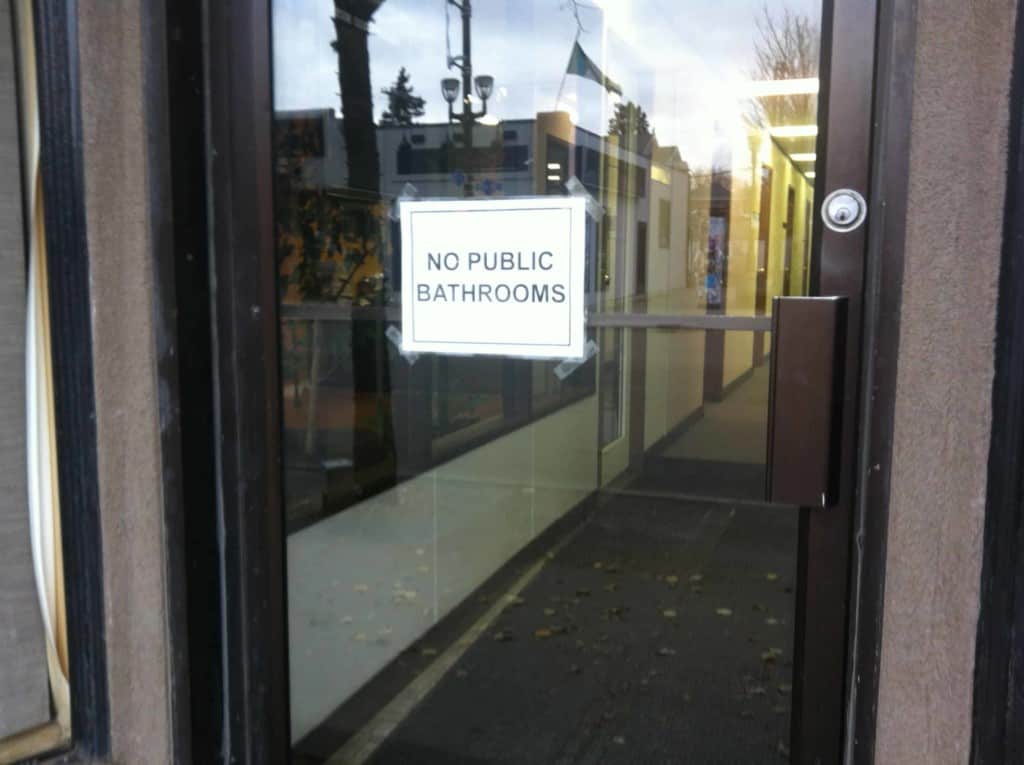Study and pilot looking at public bathrooms
When you gotta go, you gotta go, but you’re not always near a bathroom you can use when the need strikes.
In the RCP distribution area, public bathrooms exist in places like libraries, most local community leagues when open, Kingsway Mall, Safeway, and Borden Park.
Many businesses allow only paying customers to use their bathrooms. The Carrot Coffeehouse adopted this practice because of past experiences.
“A few months ago, a man used the bathroom and peed everywhere. As he was leaving, he said, ‘Good luck cleaning up,’” said Christy Morin, executive director of Arts of the Ave, the organization that runs the cafe.
Anyone can use bathrooms at Alberta Avenue Community League when it’s open. Karen Mykietka, facility manager, has had her share of experiences.
She said everyone needs to use a bathroom, but, “Some people ruin it for others. We regularly get smeared poop on the bathroom stalls. Someone pooped outside against one of the side entrances.”
When someone uses the bathroom, she’ll check in if they’re taking too long. “I’ve had to ask people to leave because they’re shooting up or whatever.”
But Mykietka can empathize. “I’ve come outside at one of the side entrances and there’s a lady peeing because it’s a kind of private knook. They’re not trying to vandalize, they just need a place to relieve themselves. As a woman, having to do your business outdoors is a very vulnerable position.”

In 2015, police issued 138 tickets in 10 different communities of the city for public urination and issued 120 tickets in 2016. The fine is $500 and doubles every time you’re charged again.
Chantile Shannon, director of neighbourhood services for the city, explained public urination and defecation may occur because of a lack of public bathrooms or people being unaware of a bathroom’s location; vulnerable people being unable to access bathrooms; and the behaviour of some individuals attending nightclubs or events.
She added, “Access to washrooms can help to reduce instances of public urination and defecation, but won’t eliminate the problem.”
In 2012, the city built a public bathroom on Whyte Avenue because of public urination and defecation after bars closed. The bathroom has transparent glazing and lighting as a safety measure. Now the city is undertaking a pilot and study to determine if more public washrooms are needed, where they’re needed, and what design is best.

Public bathrooms are convenient for everyone, including “people who are experiencing homelessness, those with young children and people with conditions that require frequent or immediate access to washroom facilities.”
But Shannon added, “Inappropriate use of washrooms can cause safety concerns, spread biohazards, make them unusable by others, require frequent cleaning and maintenance, which is costly and can present safety issues for workers that clean and maintain them.”
Bathrooms were discussed at the April 3 city council meeting with the community and public services committee. According to the committee report, 51 public bathrooms are in the city’s core: “downtown, Boyle Street, McCauley, Stony Plain Road [business area], Central McDougall, Queen Mary Park, and Oliver.”
“Based on the preliminary assessment, there may be a need for public washrooms in certain core neighbourhoods.” But, “accessibility, safety and cost” need to be considered.
How many bathrooms may be needed is a question the pilot hopes to address. The committee will present the next report to council in 2018.
PUBLIC URINATION/DEFECATION
Call the police complaint line: #377 or 780.423.4567
Featured Image: City council is debating whether or not to build more public bathrooms. | Talea Medynski







